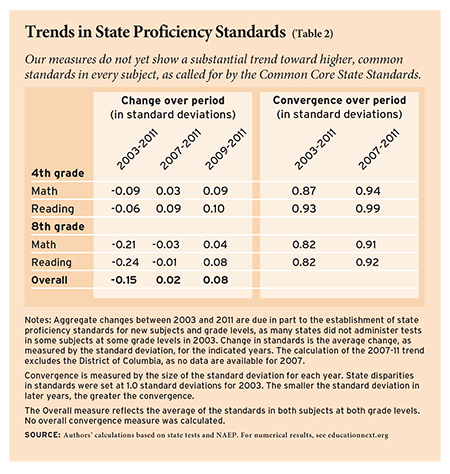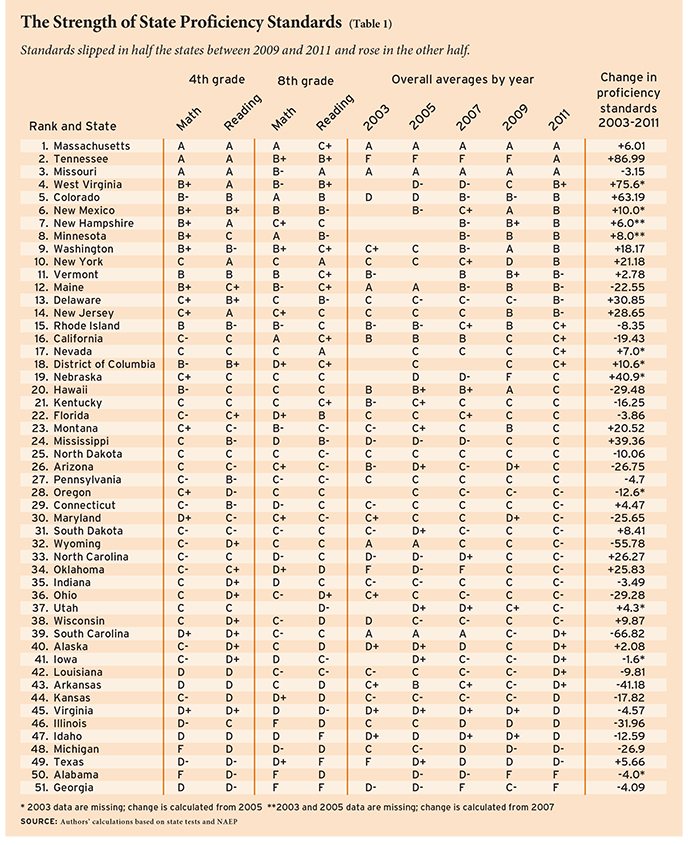Only 35 percent of U.S. 8th graders were identified as proficient in math by the 2011 National Assessment of Educational Progress (NAEP). According to the most recent calculations available, the United States stands at the 32nd rank in math among nations in the industrialized world. In reading, the U.S. ranks 17th in the world (see “Are U.S. Students Ready to Compete?” features, Fall 2011).
The low performance of U.S. students has been attributed to low expectations set by states under the 2002 federal law, No Child Left Behind (NCLB), which expects all students to reach full proficiency by 2014. In this, the fifth in a series of Education Next reports, we compare the proficiency standards set by each state to those set by NAEP, which has established its proficiency bar at levels comparable to those of international student assessments.
Most states have set their proficiency bars at much lower levels, perhaps because it causes less embarrassment when more students can make it across the proficiency bar, or because it was the easiest way for states to comply with the NCLB requirement to bring all students up to full proficiency.
Unhappy with the low level and wide variation in state standards, the National Governors Association and the Council of Chief State School Officers, with the financial backing of the Bill & Melinda Gates Foundation and the political support of the U.S. Department of Education (ED), formed a consortium in 2009 that invited each state to join in an effort to set Common Core State Standards (CCSS). Those states that take that step and institute other education reforms improve their chances of receiving an ED waiver of onerous NCLB regulations. That waiver, which has been granted to 37 states and the District of Columbia, provides a strong incentive to participate in CCSS. (Virginia is the only state to receive a waiver without adopting the standards.)
The stated CCSS goal is to set standards and proficiency bars at levels matching those established by international organizations and thereby bring the nation’s students to levels attained by peers in leading countries abroad. CCSS proponents also expect students to acquire a deep understanding of concepts and relationships. In math, for example, students are expected to justify formulas and explain their thinking rather than simply identify correct numerical relationships.
CCSS is not without its critics. Alabama and Indiana are threatening to withdraw from participation in CCSS on the grounds that the federal government is imposing a national curriculum on local school districts. In Massachusetts and California, opposition groups claim that existing state standards exceed those proposed by CCSS. Others worry because teachers unions are calling for a moratorium on stakes attached to student testing until the new CCSS standards have been fully implemented, which may take several years.
Despite the controversy, 45 states have officially adopted CCSS, pledging themselves to a high, common definition of expected student competencies, to be assessed by common tests starting in 2015. Whether or not that commitment is reflected in any lifting of standards in practice in the meantime is the question we investigate in this report.
Measuring State Proficiency Standards
We estimate each state’s actual standards by comparing the percentage of students the state identifies as proficient based on its own assessments with the percentage of the students in the state NAEP identifies as proficient. If the proficiency rates reported by the state are roughly the same as those reported by NAEP, we conclude that the state has set a high, internationally competitive standard.
To simplify presentation, we have given each state a mark of A to F, depending on the strength of its standards relative to all other states in all years for which information is available, from 2003 to 2011. Separate marks are given in reading and math for both 4th- and 8th-grade students. To obtain an overall mark for each state, we average the marks for the four grade-subject combinations. Table 1 presents the rank order of the states in 2011. It also displays the marks each state received based on assessments administered in 2003, 2005, 2007, and 2009.
Note that an A or a B does not indicate a relatively high performance by students in the state. Rather, it indicates that the state’s definition of proficient embodies higher expectations for students. It is best thought of as a high grade for “truth in advertising,” telling citizens frankly how well students are performing on an internationally accepted scale, just as states have pledged to do by joining the CCSS consortium. See the methodological sidebar for further details.
Trends in Strength of Tests
 Although not as many states earned the highest grade in 2011 as in 2009, the overall situation since 2007 has been stable. As shown in Table 2, overall standards for both math and reading in 4th and 8th grades have risen by just 0.02 standard deviations. In the most recent period, the upward shift was 0.08 standard deviations. Standards slipped in 26 states between 2009 and 2011 while rising in 24 states and the District of Columbia (see Table 1). Although standards are lower since they were first measured in 2003, most of this decline took place during the first two years the standards were in place, and some of that decline reflected the inclusion of testing in additional subjects and grade levels for which no proficiency standards had previously been provided. Many of these new standards were set at lower levels than those set by 2003 (see “Johnny Can Read…in Some States,” features, Summer 2005).
Although not as many states earned the highest grade in 2011 as in 2009, the overall situation since 2007 has been stable. As shown in Table 2, overall standards for both math and reading in 4th and 8th grades have risen by just 0.02 standard deviations. In the most recent period, the upward shift was 0.08 standard deviations. Standards slipped in 26 states between 2009 and 2011 while rising in 24 states and the District of Columbia (see Table 1). Although standards are lower since they were first measured in 2003, most of this decline took place during the first two years the standards were in place, and some of that decline reflected the inclusion of testing in additional subjects and grade levels for which no proficiency standards had previously been provided. Many of these new standards were set at lower levels than those set by 2003 (see “Johnny Can Read…in Some States,” features, Summer 2005).
The stability in proficiency standards since 2007 masks variation, depending on the grade level, the subject matter, and the specific state under consideration. A case in point is an observed eighth-grade slump. Eighth-grade standards shifted downward slightly in both reading and math between 2007 and 2011, even though states were raising them at the 4th-grade level. The changes since CCSS was put on the national agenda in 2009 have slightly reduced the divergence between state standards and the national expectations set by NAEP, however.
Although little overall change is detected, some states have made remarkable strides forward. Tennessee is the most outstanding example. Having been graded an F in every previous report, it made the astounding jump to a straight A in 2011. In 2007, the state of Tennessee recognized that its academic standards were much too lax and that schools were not encouraged to provide students with the skills necessary to compete in the modern job market. With the support of his state department of education and board of education, then governor Phil Bredesen led a concerted, highly publicized effort to revamp the state standards. As a result, state tests were made much more challenging and the percentage of students identified as proficient dropped from 90 percent or more to around 50 percent, a candid admission of the challenges the Tennessee schools faced. The remarkable transition in Tennessee shows that states are capable of dramatic reform when the political leadership is committed to focusing public attention on the problem.
Major Changes in State Ranking
In addition to Tennessee’s upward move, West Virginia, New York, Nebraska, and Delaware made significant improvements in their proficiency standards, climbing a full letter grade from where they had been in 2009. But those gains are offset by drops of at least one full letter grade between 2009 and 2011 in New Mexico, Washington, Hawaii, Montana, and Georgia.
Overall, only three states (Massachusetts, Tennessee, and Missouri) received A marks in 2011, down from five such states in 2009. Only the highest ranked state, Massachusetts, actually set a proficiency standard higher than the NAEP standard—in 4th-grade math.
As mentioned, receiving an A does not indicate that a high percentage of students in a state are proficient. It only means that high expectations have been set. Although Tennessee and Missouri established the same expectations as Massachusetts, somewhere between 10 percent and 25 percent fewer students in the “Volunteer” and “Show Me” states reached the proficiency level, the exact percentage varying with the subject and grade level being tested. Yet all three states deserve an A for telling the plain truth about their performance levels. In other words, Missouri has earned its moniker, despite its relatively low level of student performance.
The same positive evaluation cannot be given to the rest of the states. Ten received a B, 24 states a C, and 11 a D. Two states—Alabama and Georgia—received an F.
Alabama has received an F ever since our survey began. But states are not doomed to bottom-feeding status. Not only Tennessee, but also Nebraska, has lifted itself from the bottom tier since 2009.
States Are Converging—Slowly
Proponents of CCSS not only want to raise state standards; they also want states to converge on a common standard. In Table 2, state disparities in standards in 2003 were set at 1.0 standard deviations; any drop in that coefficient indicates a convergence among the states.
Generally speaking, there has been a shift toward convergence in the eight years between 2003 and 2011. Much of the convergence reflects the addition of standards set after 2003. The comparison between 2007 and 2011 is particularly instructive, as we have a complete set of proficiency standards for all 50 states for both years. Convergence is detected in 8th-grade reading and math standards. That would be good news were it not for the fact that 8th-grade standards also declined between 2003 and 2011. What has not happened is a substantial trend toward higher, common standards in every subject as called for by CCSS.
When states originally set proficiency bars, as required by NCLB, they may have set low standards in order to ease compliance with federal requirements to bring all students across the bar. Now that a sizable majority of the states have received waivers from compliance with most NCLB regulations, they have the opportunity to reevaluate their standards and bring them up to par. A few states, most notably Tennessee, have responded to the challenge. One can only hope that CCSS is now working to strengthen this trend. Only by holding our next generation to the highest global standards and providing quality education to match can the United States hope to compete in the world.
Paul Peterson is professor of government and director of the Program on Education Policy and Governance at Harvard University and senior fellow at the Hoover Institution at Stanford University. Peter Kaplan is pursuing a bachelor’s degree in government at Harvard University.
This article appeared in the Fall 2013 issue of Education Next. Suggested citation format:
Peterson, P.E., and Kaplan, P. (2013). Despite Common Core, States Still Lack Common Standards: Students proficient on state tests but not national. Education Next, 13(4), 44-49.




